TkMYB7 Coordinates Jasmonate and Ethylene Signaling to Regulate Natural Rubber Biosynthesis in Taraxacum kok-saghyz
Abstract
1. Introduction
2. Results
2.1. Identification and Phylogenetic Analysis of the TkMYB Gene Family
2.2. Transcriptome Analysis of Ethylene and Methyl Jasmonate Responses in the TkMYB Gene Family
2.3. Analysis of Conserved Domains, Gene Structure, and Protein Physicochemical Properties of TkMYB Family Members
2.4. Cloning and Subcellular Localization Analysis of TkMYB7
2.5. Transcriptome and Promoter Analysis of MVA Pathway Genes
2.6. Y1H Experiment Proves That TkMYB7 Can Regulate TkACAT5 in the MVA Pathway
2.7. Stable Inheritance of TkMYB7 in Arabidopsis thaliana
3. Discussion
4. Materials and Methods
4.1. Plant Materials and Treatments
4.2. Identification and Characterization of MYB Genes in TKS
4.3. Transcriptome Data Analysis
4.4. Subcellular Localization Analysis of TkMYB Proteins
4.5. Screening for Downstream Genes of TkMYB7
4.6. Yeast One-Hybrid Bait Vector Construction and Validation (Aiming to Eliminate False Positives)
4.7. Phenotypic Identification and Statistical Analysis of Seed Germination and Root Growth in Transgenic Lines
5. Conclusions
Supplementary Materials
Author Contributions
Funding
Data Availability Statement
Acknowledgments
Conflicts of Interest
References
- McAssey, E.V.; Gudger, E.G.; Zuellig, M.P.; Burke, J.M. Population Genetics of the Rubber-Producing Russian Dandelion (Taraxacum kok-saghyz). PLoS ONE 2016, 11, e0146417. [Google Scholar] [CrossRef]
- van Beilen, J.B.; Poirier, Y. Establishment of New Crops for the Production of Natural Rubber. Trends Biotechnol. 2007, 25, 522–529. [Google Scholar] [CrossRef]
- Yamashita, S.; Takahashi, S. Molecular Mechanisms of Natural Rubber Biosynthesis. Annu. Rev. Biochem. 2020, 89, 821–851. [Google Scholar] [CrossRef]
- Lin, T.; Xu, X.; Ruan, J.; Liu, S.; Wu, S.; Shao, X.; Wang, X.; Gan, L.; Qin, B.; Yang, Y.; et al. Genome Analysis of Taraxacum kok-saghyz Rodin Provides New Insights into Rubber Biosynthesis. Natl. Sci. Rev. 2018, 5, 78–87. [Google Scholar] [CrossRef]
- Dong, G.; Wang, H.; Qi, J.; Leng, Y.; Huang, J.; Zhang, H.; Yan, J. Transcriptome Analysis of Taraxacum kok-saghyz Reveals the Role of Exogenous Methyl Jasmonate in Regulating Rubber Biosynthesis and Drought Tolerance. Gene 2023, 867, 147346. [Google Scholar] [CrossRef]
- van Deenen, N.; Unland, K.; Prüfer, D.; Schulze Gronover, C. Oxidosqualene Cyclase Knock-Down in Latex of Taraxacum koksaghyz Reduces Triterpenes in Roots and Separated Natural Rubber. Molecules 2019, 24, 2703. [Google Scholar] [CrossRef] [PubMed]
- Sun, J.-Q.; Jiang, H.-L.; Li, C.-Y. Systemin/Jasmonate-Mediated Systemic Defense Signaling in Tomato. Mol. Plant 2011, 4, 607–615. [Google Scholar] [CrossRef] [PubMed]
- Ahmad, P.; Rasool, S.; Gul, A.; Sheikh, S.A.; Akram, N.A.; Ashraf, M.; Kazi, A.M.; Gucel, S. Jasmonates: Multifunctional Roles in Stress Tolerance. Front. Plant Sci. 2016, 7, 813. [Google Scholar] [CrossRef]
- Wang, X.; Zhang, J.; Song, J.; Huang, M.; Cai, J.; Zhou, Q.; Dai, T.; Jiang, D. Abscisic Acid and Hydrogen Peroxide Are Involved in Drought Priming-Induced Drought Tolerance in Wheat (Triticum aestivum L.). Plant Biol. 2020, 22, 1113–1122. [Google Scholar] [CrossRef]
- Awan, S.A.; Khan, I.; Rizwan, M.; Zhang, X.; Brestic, M.; Khan, A.; El-Sheikh, M.A.; Alyemeni, M.N.; Ali, S.; Huang, L. Exogenous Abscisic Acid and Jasmonic Acid Restrain Polyethylene Glycol-Induced Drought by Improving the Growth and Antioxidative Enzyme Activities in Pearl Millet. Physiol. Plant 2021, 172, 809–819. [Google Scholar] [CrossRef]
- Afrin, S.; Huang, J.-J.; Luo, Z.-Y. JA-Mediated Transcriptional Regulation of Secondary Metabolism in Medicinal Plants. Sci. Bull. 2015, 60, 1062–1072. [Google Scholar] [CrossRef]
- Hong, H.; Xiao, H.; Yuan, H.; Zhai, J.; Huang, X. Cloning and Characterisation of JAZ Gene Family in Hevea brasiliensis. Plant Biol. 2015, 17, 618–624. [Google Scholar] [CrossRef] [PubMed]
- Hao, B.Z.; Wu, J.L.; Yan, C.Y.; Hao, B.Z.; Wu, J.L.; Yan, C.Y. Acceleration of Laticifer Differentiation in Hevea brasiliensis by Latex Drainage. Chin. J. Trop. Crops 1985, 5, 19–23. [Google Scholar]
- Laosombut, T.; Arreewichit, P.; Nirapathpongporn, K.; Traiperm, P.; Kongsawadworakul, P.; Viboonjun, U.; Narangajavana, J. Differential Expression of Methyl Jasmonate-Responsive Genes Correlates with Laticifer Vessel Proliferation in Phloem Tissue of Rubber Tree (Hevea brasiliensis). J. Plant Growth Regul. 2016, 35, 1049–1063. [Google Scholar] [CrossRef]
- Zhao, Y.; Zhou, L.-M.; Chen, Y.-Y.; Yang, S.-G.; Tian, W.-M. MYC Genes with Differential Responses to Tapping, Mechanical Wounding, Ethrel and Methyl Jasmonate in Laticifers of Rubber Tree (Hevea brasiliensis Muell. Arg.). J. Plant Physiol. 2011, 168, 1649–1658. [Google Scholar] [CrossRef]
- Deng, X.; Guo, D.; Yang, S.; Shi, M.; Chao, J.; Li, H.; Peng, S.; Tian, W. Jasmonate Signalling in the Regulation of Rubber Biosynthesis in Laticifer Cells of Rubber Tree, Hevea brasiliensis. J. Exp. Bot. 2018, 69, 3559–3571. [Google Scholar] [CrossRef] [PubMed]
- Wu, Y.; Liu, Y.; Zhang, Y.; Dong, G.; Yan, J.; Zhang, H. Functional Analysis of TkWRKY33: A Key Regulator in Drought-Induced Natural Rubber Synthesis in Taraxacum kok-saghyz. Plant Physiol. Biochem. 2024, 217, 109232. [Google Scholar] [CrossRef]
- Qin, B.; Fan, S.-L.; Yu, H.-Y.; Lu, Y.-X.; Wang, L.-F. HbMYB44, a Rubber Tree MYB Transcription Factor with Versatile Functions in Modulating Multiple Phytohormone Signaling and Abiotic Stress Responses. Front. Plant Sci. 2022, 13, 893896. [Google Scholar] [CrossRef] [PubMed]
- Wang, Y.; Zhan, D.-F.; Li, H.-L.; Guo, D.; Zhu, J.-H.; Peng, S.-Q. Transcriptome-Wide Identification and Characterization of MYB Transcription Factor Genes in the Laticifer Cells of Hevea Brasiliensis. Front. Plant Sci. 2017, 8, 1974. [Google Scholar] [CrossRef]
- Fan, S.; Lu, L.; Fan, X.; Liu, M.; Yang, H.; Guo, B.; Dai, L.; Wang, L. A Comprehensive Analysis of MYB Aimed at Identifying Genes Involved in the Regulation of Natural Rubber Biosynthesis. Ind. Crops Prod. 2025, 230, 121114. [Google Scholar] [CrossRef]
- Li, Y.; Li, Z.; Xu, T.; Yang, X.; Zhang, Y.; Qi, J.; Wang, J.; Xie, Q.; Liu, K.; Tang, C. The MYB-Related Transcription Factor Family in Rubber Dandelion (Taraxacum kok-saghyz): An Insight into a Latex-Predominant Member, TkMYBR090. Int. J. Biol. Macromol. 2025, 305, 141058. [Google Scholar] [CrossRef] [PubMed]
- Dubois, M.; Van den Broeck, L.; Inzé, D. The Pivotal Role of Ethylene in Plant Growth. Trends Plant Sci. 2018, 23, 311–323. [Google Scholar] [CrossRef]
- Dusotoit-Coucaud, A.; Kongsawadworakul, P.; Maurousset, L.; Viboonjun, U.; Brunel, N.; Pujade-Renaud, V.; Chrestin, H.; Sakr, S. Ethylene Stimulation of Latex Yield Depends on the Expression of a Sucrose Transporter (HbSUT1B) in Rubber Tree (Hevea brasiliensis). Tree Physiol. 2010, 30, 1586–1598. [Google Scholar] [CrossRef]
- Yang, H.; Dai, L.; Liu, M.; Fan, X.; Lu, L.; Guo, B.; Wang, Z.; Wang, L. Integrative Analysis of Transcriptome and Metabolome Reveals How Ethylene Increases Natural Rubber Yield in Hevea Brasiliensis. Front. Plant Sci. 2024, 15, 1444693. [Google Scholar] [CrossRef]
- Hua, J.; Liu, Y.; Xiao, C.-J.; Jing, S.-X.; Luo, S.-H.; Li, S.-H. Chemical Profile and Defensive Function of the Latex of Euphorbia peplus. Phytochemistry 2017, 136, 56–64. [Google Scholar] [CrossRef] [PubMed]
- Kitajima, S.; Aoki, W.; Shibata, D.; Nakajima, D.; Sakurai, N.; Yazaki, K.; Munakata, R.; Taira, T.; Kobayashi, M.; Aburaya, S.; et al. Comparative Multi-Omics Analysis Reveals Diverse Latex-Based Defense Strategies against Pests among Latex-Producing Organs of the Fig Tree (Ficus carica). Planta 2018, 247, 1423–1438. [Google Scholar] [CrossRef]
- Tang, C.; Yang, M.; Fang, Y.; Luo, Y.; Gao, S.; Xiao, X.; An, Z.; Zhou, B.; Zhang, B.; Tan, X.; et al. The Rubber Tree Genome Reveals New Insights into Rubber Production and Species Adaptation. Nat. Plants 2016, 2, 16073. [Google Scholar] [CrossRef]
- Tungngoen, K.; Viboonjun, U.; Kongsawadworakul, P.; Katsuhara, M.; Julien, J.-L.; Sakr, S.; Chrestin, H.; Narangajavana, J. Hormonal Treatment of the Bark of Rubber Trees (Hevea brasiliensis) Increases Latex Yield through Latex Dilution in Relation with the Differential Expression of Two Aquaporin Genes. J. Plant Physiol 2011, 168, 253–262. [Google Scholar] [CrossRef]
- Wu, X.; Xia, M.; Su, P.; Zhang, Y.; Tu, L.; Zhao, H.; Gao, W.; Huang, L.; Hu, Y. MYB Transcription Factors in Plants: A Comprehensive Review of Their Discovery, Structure, Classification, Functional Diversity and Regulatory Mechanism. Int. J. Biol. Macromol 2024, 282, 136652. [Google Scholar] [CrossRef]
- Stracke, R.; Werber, M.; Weisshaar, B. The R2R3-MYB Gene Family in Arabidopsis thaliana. Curr. Opin. Plant Biol. 2001, 4, 447–456. [Google Scholar] [CrossRef] [PubMed]
- Jin, H.; Martin, C. Multifunctionality and Diversity within the Plant MYB-Gene Family. Plant Mol. Biol. 1999, 41, 577–585. [Google Scholar] [CrossRef]
- Chen, Z.; Wu, Z.; Dong, W.; Liu, S.; Tian, L.; Li, J.; Du, H. MYB Transcription Factors Becoming Mainstream in Plant Roots. Int. J. Mol. Sci. 2022, 23, 9262. [Google Scholar] [CrossRef]
- Zhao, Q.; Li, M.; Jia, Z.; Liu, F.; Ma, H.; Huang, Y.; Song, S. AtMYB44 Positively Regulates the Enhanced Elongation of Primary Roots Induced by N-3-Oxo-Hexanoyl-Homoserine Lactone in Arabidopsis thaliana. Mol. Plant Microbe Interact. 2016, 29, 774–785. [Google Scholar] [CrossRef] [PubMed]
- Yang, Y.; Zhang, L.; Chen, P.; Liang, T.; Li, X.; Liu, H. UV-B Photoreceptor UVR8 Interacts with MYB73/MYB77 to Regulate Auxin Responses and Lateral Root Development. EMBO J. 2020, 39, e101928. [Google Scholar] [CrossRef] [PubMed]
- Gibbs, D.J.; Voß, U.; Harding, S.A.; Fannon, J.; Moody, L.A.; Yamada, E.; Swarup, K.; Nibau, C.; Bassel, G.W.; Choudhary, A.; et al. AtMYB93 Is a Novel Negative Regulator of Lateral Root Development in Arabidopsis. New Phytol. 2014, 203, 1194–1207. [Google Scholar] [CrossRef]
- Xie, N.; Huang, X.; Zhou, J.; Song, X.; Lin, J.; Yan, M.; Zhu, M.; Li, J.; Wang, K. The R2R3-MYB Transcription Factor CsMYB42 Regulates Theanine Biosynthesis in Albino Tea Leaves. Plant Sci. 2023, 336, 111850. [Google Scholar] [CrossRef]
- Chen, F.; He, Y.; Yao, X.; Zho, B.; Tian, S.; Yin, J.; Lu, L. CsMOF1-Guided Regulation of Drought-Induced Theanine Biosynthesis in Camellia Sinensis. Int. J. Biol. Macromol 2024, 268, 131725. [Google Scholar] [CrossRef]
- Li, L.-X.; Fang, Y.; Li, D.; Zhu, Z.-H.; Zhang, Y.; Tang, Z.-Y.; Li, T.; Chen, X.-S.; Feng, S.-Q. Transcription Factors MdMYC2 and MdMYB85 Interact with Ester Aroma Synthesis Gene MdAAT1 in Apple. Plant Physiol. 2023, 193, 2442–2458. [Google Scholar] [CrossRef] [PubMed]
- Song, Q.; Kong, L.; Yang, X.; Jiao, B.; Hu, J.; Zhang, Z.; Xu, C.; Luo, K. PtoMYB142, a Poplar R2R3-MYB Transcription Factor, Contributes to Drought Tolerance by Regulating Wax Biosynthesis. Tree Physiol. 2022, 42, 2133–2147. [Google Scholar] [CrossRef]
- Lau, N.-S.; Makita, Y.; Kawashima, M.; Taylor, T.D.; Kondo, S.; Othman, A.S.; Shu-Chien, A.C.; Matsui, M. The Rubber Tree Genome Shows Expansion of Gene Family Associated with Rubber Biosynthesis. Sci. Rep. 2016, 6, 28594. [Google Scholar] [CrossRef]
- Vranová, E.; Coman, D.; Gruissem, W. Network Analysis of the MVA and MEP Pathways for Isoprenoid Synthesis. Annu. Rev. Plant Biol. 2013, 64, 665–700. [Google Scholar] [CrossRef]
- Dong, G.; Fan, M.; Wang, H.; Leng, Y.; Sun, J.; Huang, J.; Zhang, H.; Yan, J. Functional Characterization of TkSRPP Promoter in Response to Hormones and Wounding Stress in Transgenic Tobacco. Plants 2023, 12, 252. [Google Scholar] [CrossRef] [PubMed]
- Kranz, H.D.; Denekamp, M.; Greco, R.; Jin, H.; Leyva, A.; Meissner, R.C.; Petroni, K.; Urzainqui, A.; Bevan, M.; Martin, C.; et al. Towards Functional Characterisation of the Members of the R2R3-MYB Gene Family from Arabidopsis thaliana. Plant J. 1998, 16, 263–276. [Google Scholar] [CrossRef] [PubMed]
- Dubos, C.; Stracke, R.; Grotewold, E.; Weisshaar, B.; Martin, C.; Lepiniec, L. MYB Transcription Factors in Arabidopsis. Trends Plant Sci. 2010, 15, 573–581. [Google Scholar] [CrossRef]
- Wang, X.; Zhao, S.; Zhou, R.; Liu, Y.; Guo, L.; Hu, H. Identification of Vitis Vinifera MYB Transcription Factors and Their Response against Grapevine Berry Inner Necrosis Virus. BMC Plant Biol. 2023, 23, 279. [Google Scholar] [CrossRef]
- Zhao, H.; Ji, Y.; Jiang, Y.; Liang, X.; Qiao, Y.; Chen, F.; Wu, L.; Yu, Y.; Ma, D. Identification and Expression Analysis of Rice MYB Family Members in Response to Heat Stress. Plants 2025, 14, 1784. [Google Scholar] [CrossRef]
- Cao, X.; Yan, J.; Lei, J.; Li, J.; Zhu, J.; Zhang, H. De Novo Transcriptome Sequencing of MeJA-Induced Taraxacum Koksaghyz Rodin to Identify Genes Related to Rubber Formation. Sci. Rep. 2017, 7, 15697. [Google Scholar] [CrossRef]
- Chen, C.; Zhang, Z.; Lei, Y.-Y.; Chen, W.-J.; Zhang, Z.-H.; Li, X.-M.; Dai, H.-Y. MdMYB44-like Positively Regulates Salt and Drought Tolerance via the MdPYL8-MdPP2CA Module in Apple. Plant J. 2024, 118, 24–41. [Google Scholar] [CrossRef]
- Wu, Q.; Tao, Y.; Huang, J.; Liu, Y.S.; Yang, X.Z.; Jing, H.K.; Shen, R.F.; Zhu, X.F. The MYB Transcription Factor MYB103 Acts Upstream of TRICHOME BIREFRINGENCE-LIKE27 in Regulating Aluminum Sensitivity by Modulating the O-Acetylation Level of Cell Wall Xyloglucan in Arabidopsis thaliana. Plant J. 2022, 111, 529–545. [Google Scholar] [CrossRef]
- Wei, Q.; Liu, Y.; Lan, K.; Wei, X.; Hu, T.; Chen, R.; Zhao, S.; Yin, X.; Xie, T. Identification and Analysis of MYB Gene Family for Discovering Potential Regulators Responding to Abiotic Stresses in Curcuma Wenyujin. Front. Genet. 2022, 13, 894928. [Google Scholar] [CrossRef] [PubMed]
- Yang, A.; Dai, X.; Zhang, W.-H. A R2R3-Type MYB Gene, OsMYB2, Is Involved in Salt, Cold, and Dehydration Tolerance in Rice. J. Exp. Bot. 2012, 63, 2541–2556. [Google Scholar] [CrossRef]
- Hu, J.; Zou, S.; Huang, J.; Huan, X.; Jin, X.; Zhou, L.; Zhao, K.; Han, Y.; Wang, S. PagMYB151 Facilitates Proline Accumulation to Enhance Salt Tolerance of Poplar. BMC Genom. 2023, 24, 345. [Google Scholar] [CrossRef] [PubMed]
- Gao, L.; Lv, Q.; Wang, L.; Han, S.; Wang, J.; Chen, Y.; Zhu, W.; Zhang, X.; Bao, F.; Hu, Y.; et al. Abscisic Acid-Mediated Autoregulation of the MYB41-BRAHMA Module Enhances Drought Tolerance in Arabidopsis. Plant Physiol. 2024, 196, 1608–1626. [Google Scholar] [CrossRef]
- Yang, J.; Zhang, B.; Gu, G.; Yuan, J.; Shen, S.; Jin, L.; Lin, Z.; Lin, J.; Xie, X. Genome-Wide Identification and Expression Analysis of the R2R3-MYB Gene Family in Tobacco (Nicotiana tabacum L.). BMC Genom. 2022, 23, 432. [Google Scholar] [CrossRef] [PubMed]
- Chen, D.; Chen, H.; Dai, G.; Zhang, H.; Liu, Y.; Shen, W.; Zhu, B.; Cui, C.; Tan, C. Genome-Wide Identification of R2R3-MYB Gene Family and Association with Anthocyanin Biosynthesis in Brassica Species. BMC Genom. 2022, 23, 441. [Google Scholar] [CrossRef] [PubMed]
- Chen, C.; Chen, H.; Zhang, Y.; Thomas, H.R.; Frank, M.H.; He, Y.; Xia, R. TBtools: An Integrative Toolkit Developed for Interactive Analyses of Big Biological Data. Mol. Plant 2020, 13, 1194–1202. [Google Scholar] [CrossRef]
- Wang, H.; Zhai, L.; Wang, S.; Zheng, B.; Hu, H.; Li, X.; Bian, S. Identification of R2R3-MYB Family in Blueberry and Its Potential Involvement of Anthocyanin Biosynthesis in Fruits. BMC Genom. 2023, 24, 505. [Google Scholar] [CrossRef]
- Kumar, S.; Stecher, G.; Tamura, K. MEGA7: Molecular Evolutionary Genetics Analysis Version 7.0 for Bigger Datasets. Mol. Biol. Evol. 2016, 33, 1870–1874. [Google Scholar] [CrossRef]
- Letunic, I.; Bork, P. Interactive Tree Of Life (iTOL) v5: An Online Tool for Phylogenetic Tree Display and Annotation. Nucleic Acids Res. 2021, 49, W293–W296. [Google Scholar] [CrossRef]
- Zhao, Y.; Li, M.-C.; Konaté, M.M.; Chen, L.; Das, B.; Karlovich, C.; Williams, P.M.; Evrard, Y.A.; Doroshow, J.H.; McShane, L.M. TPM, FPKM, or Normalized Counts? A Comparative Study of Quantification Measures for the Analysis of RNA-Seq Data from the NCI Patient-Derived Models Repository. J. Transl. Med. 2021, 19, 269. [Google Scholar] [CrossRef]
- Miao, Y.; Jiang, L. Transient Expression of Fluorescent Fusion Proteins in Protoplasts of Suspension Cultured Cells. Nat. Protoc. 2007, 2, 2348–2353. [Google Scholar] [CrossRef] [PubMed]
- Clough, S.J.; Bent, A.F. Floral Dip: A Simplified Method for Agrobacterium-Mediated Transformation of Arabidopsis thaliana. Plant J. 1998, 16, 735–743. [Google Scholar] [CrossRef] [PubMed]
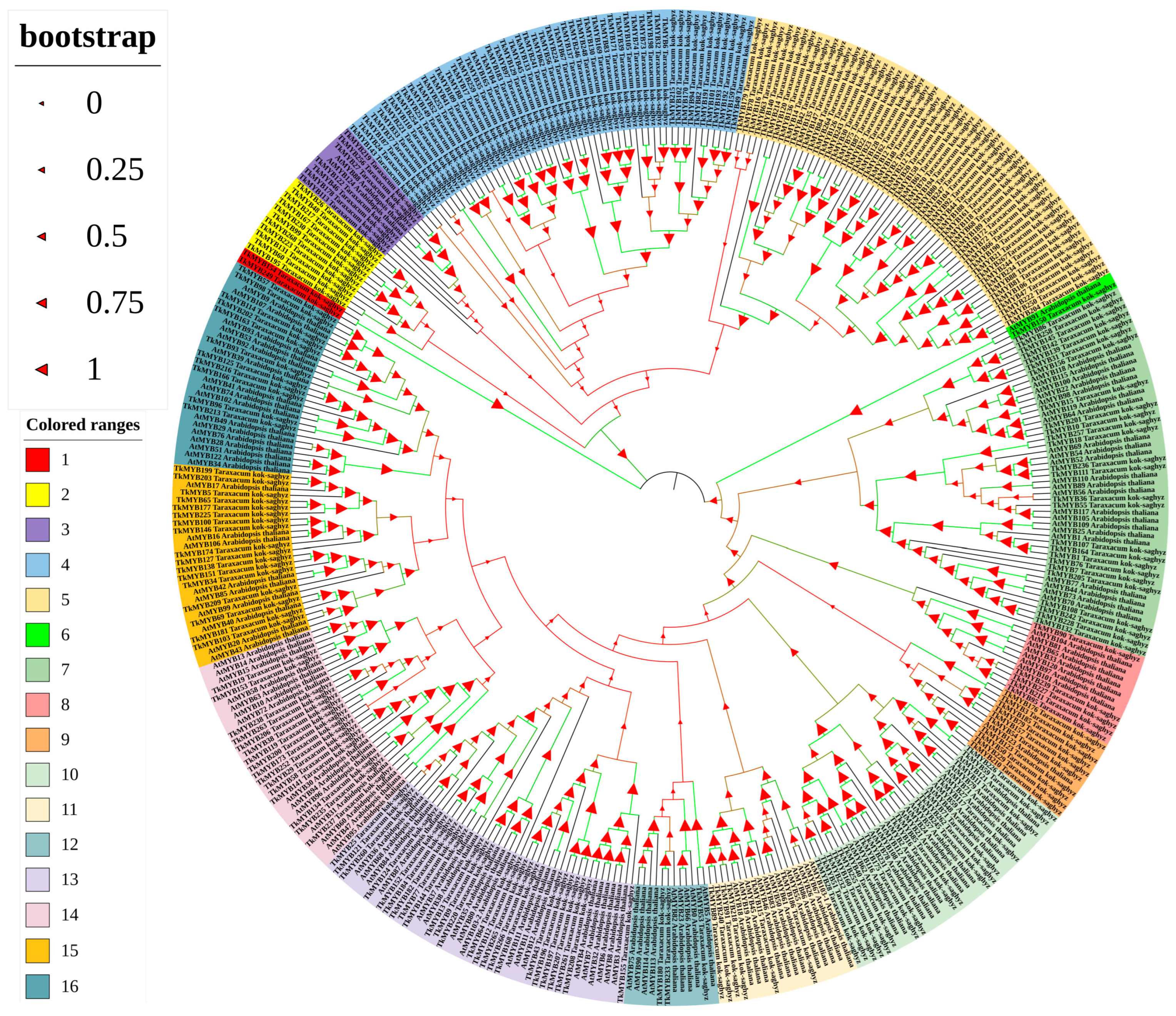
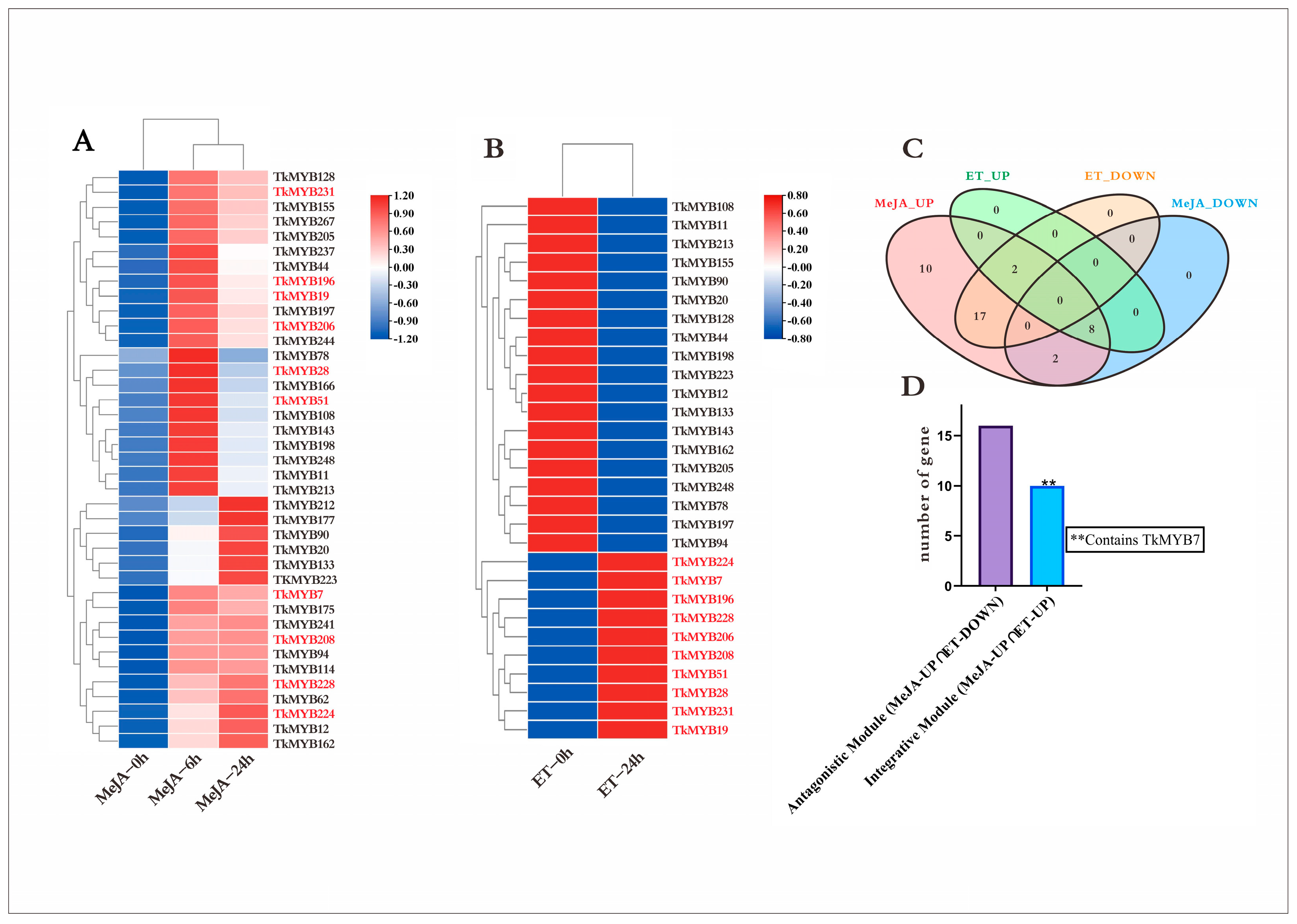
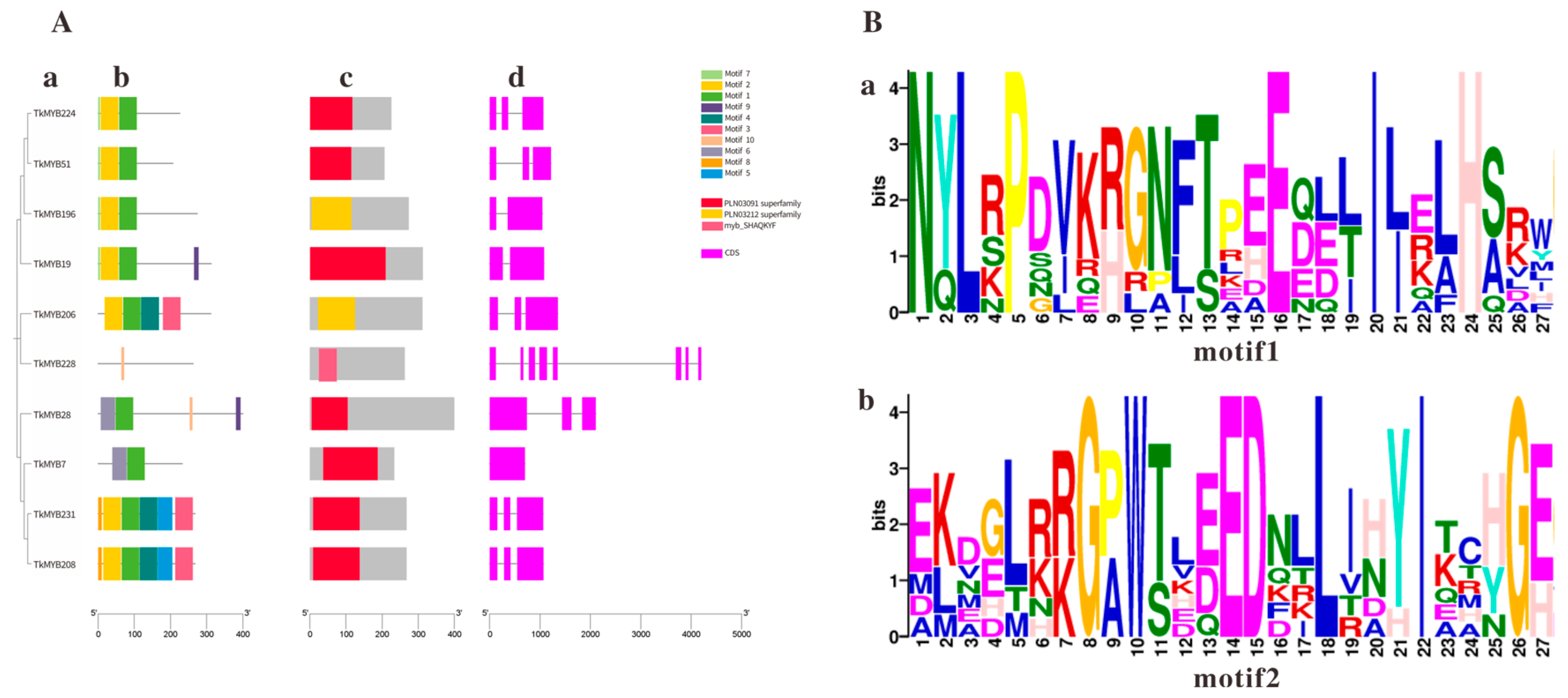
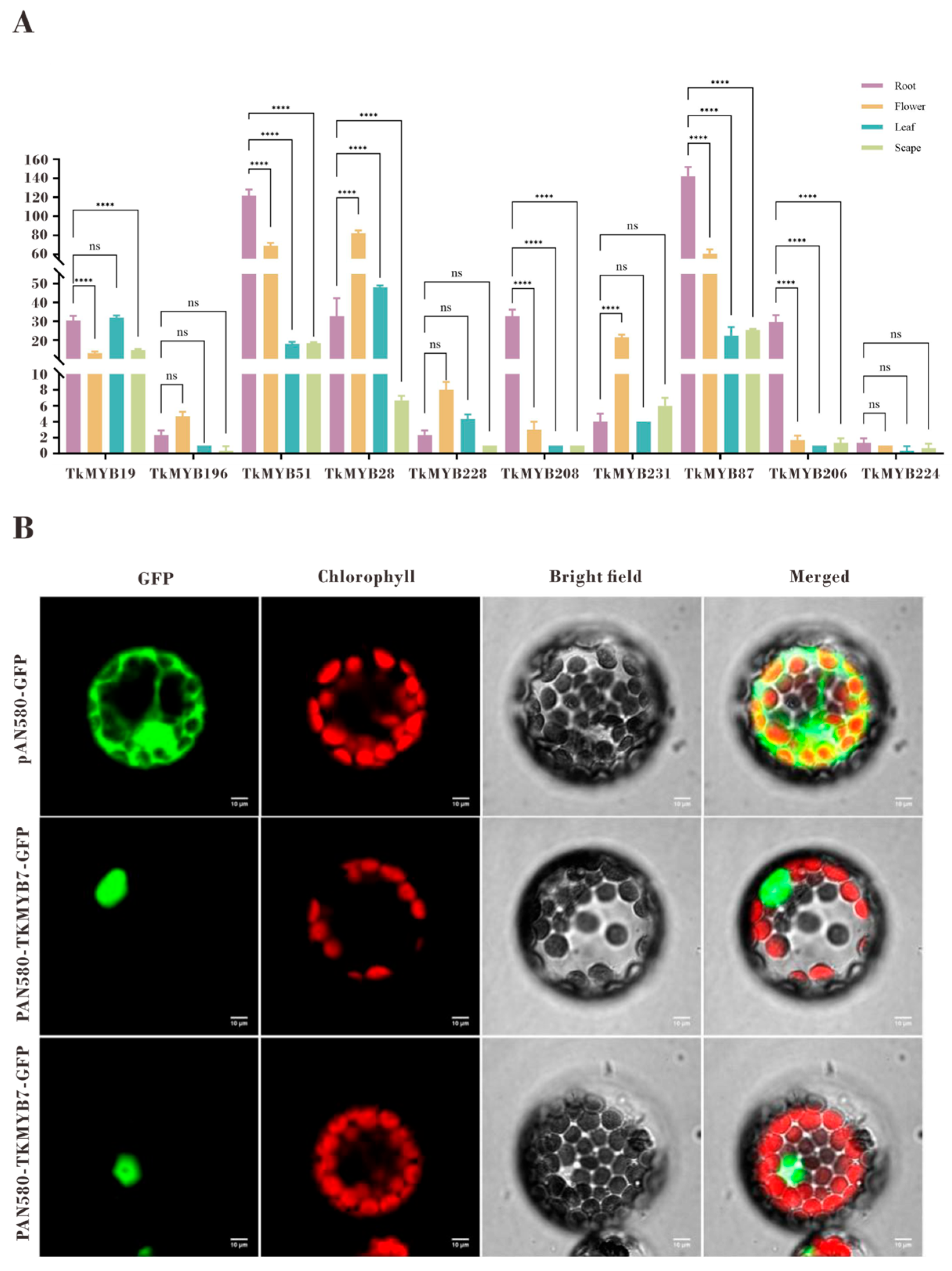


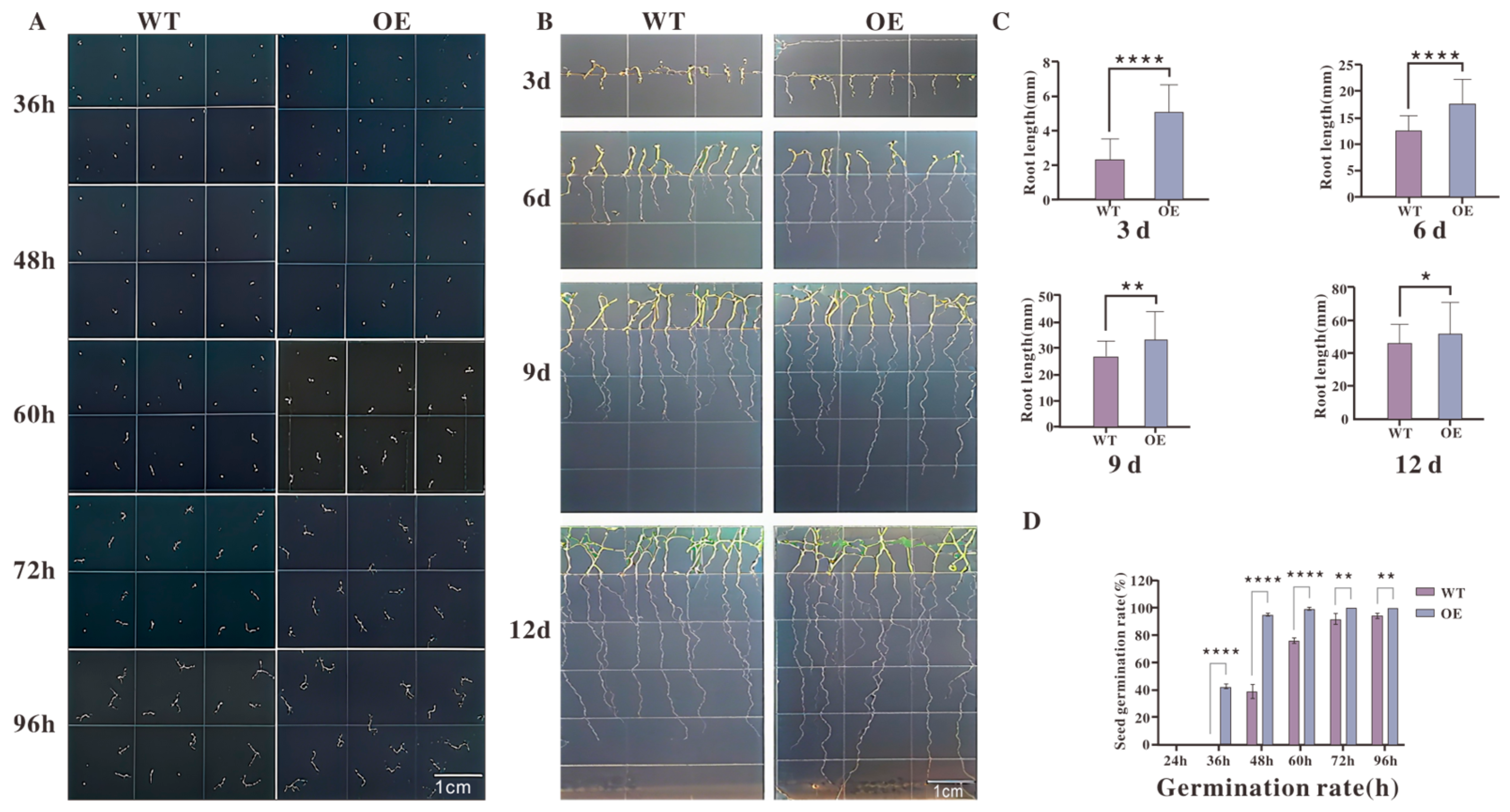
| Gene Name | ID (2017) [4] | Amino Acid | Molecular Weight (kDa) | Theoretical pI | Instability Index | GRAVY | Predicted Location |
|---|---|---|---|---|---|---|---|
| TkMYB7 | evm.model.utg478.9 | 233 | 26.06 | 7.68 | 57.59 | −0.745 | Nucleus |
| TkMYB224 | evm.model.utg1206.14 | 226 | 25.9 | 6.18 | 50.39 | −0.803 | Nucleus |
| TkMYB206 | evm.model.utg25688.5 | 312 | 35.42 | 5.77 | 47.79 | −0.775 | Nucleus |
| TkMYB196 | evm.model.utg20126.1 | 274 | 30.75 | 5.94 | 48.42 | −0.87 | Nucleus |
| TkMYB228 | evm.model.utg24099.1 | 262 | 28.98 | 7.03 | 46.51 | −0.59 | Nucleus |
| TkMYB19 | evm.model.utg22022.2 | 313 | 34.92 | 9.14 | 56.04 | −0.795 | Nucleus |
| TkMYB231 | evm.model.utg1784.24 | 268 | 31.04 | 6.83 | 52.52 | −0.848 | Nucleus |
| TkMYB208 | evm.model.utg3625.1 | 268 | 31.06 | 6.83 | 54.52 | −0.858 | Nucleus |
| TkMYB51 | evm.model.utg21778.3 | 207 | 24.35 | 7.70 | 65.70 | −1.114 | Nucleus |
| TkMYB28 | evm.model.utg24885.2 | 400 | 45.05 | 9.97 | 63.54 | −0.578 | Nucleus |
Disclaimer/Publisher’s Note: The statements, opinions and data contained in all publications are solely those of the individual author(s) and contributor(s) and not of MDPI and/or the editor(s). MDPI and/or the editor(s) disclaim responsibility for any injury to people or property resulting from any ideas, methods, instructions or products referred to in the content. |
© 2025 by the authors. Licensee MDPI, Basel, Switzerland. This article is an open access article distributed under the terms and conditions of the Creative Commons Attribution (CC BY) license (https://creativecommons.org/licenses/by/4.0/).
Share and Cite
Li, X.; Wu, Y.; Zhang, C.; Dong, G.; Xu, L.; Geng, Y.; Guo, Z.; Zhang, Y.; Yan, J. TkMYB7 Coordinates Jasmonate and Ethylene Signaling to Regulate Natural Rubber Biosynthesis in Taraxacum kok-saghyz. Plants 2025, 14, 3323. https://doi.org/10.3390/plants14213323
Li X, Wu Y, Zhang C, Dong G, Xu L, Geng Y, Guo Z, Zhang Y, Yan J. TkMYB7 Coordinates Jasmonate and Ethylene Signaling to Regulate Natural Rubber Biosynthesis in Taraxacum kok-saghyz. Plants. 2025; 14(21):3323. https://doi.org/10.3390/plants14213323
Chicago/Turabian StyleLi, Xiaodong, Yulin Wu, Changping Zhang, Gaoquan Dong, Lin Xu, Yuya Geng, Zihan Guo, Yan Zhang, and Jie Yan. 2025. "TkMYB7 Coordinates Jasmonate and Ethylene Signaling to Regulate Natural Rubber Biosynthesis in Taraxacum kok-saghyz" Plants 14, no. 21: 3323. https://doi.org/10.3390/plants14213323
APA StyleLi, X., Wu, Y., Zhang, C., Dong, G., Xu, L., Geng, Y., Guo, Z., Zhang, Y., & Yan, J. (2025). TkMYB7 Coordinates Jasmonate and Ethylene Signaling to Regulate Natural Rubber Biosynthesis in Taraxacum kok-saghyz. Plants, 14(21), 3323. https://doi.org/10.3390/plants14213323






